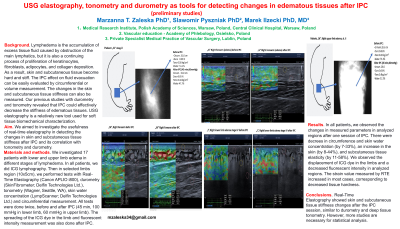Clinical Research
(CR-063) USG elastography, tonometry and durometry as a tools for detecting changes in edematous tissues after IPC (preliminary studies).
Friday, April 28, 2023
7:15 PM - 8:30 PM East Coast USA Time

Marek Ilzecki, PhD, MD; Slawomir Pyszniak, PhD
Introduction: Lymphedema is the accumulation of excess tissue fluid caused by obstruction of the main lymphatics. Still, it is also a continuing process of proliferation of keratinocytes, fibroblasts, adipocytes, and collagen deposition. As a result, skin and subcutaneous tissue become hard and stiff. The IPC effect on fluid evacuation can be easily evaluated by circumferential or volume measurement. The changes in the skin and subcutaneous tissue stiffness can also be measured. Our previous studies with durometry and tonometry revealed that IPC could effectively decrease the stiffness of edematous tissues. USG elastography is a relatively new tool used for soft tissue biomechanical characterization.
Aim. We aimed to investigate the usefulness ofreal-time elastography in detecting the changes in skin and subcutaneous tissue stiffness after IPC and its correlation with tonometry and durometry.
Methods: . We investigated 17 patients with lower and upper limb edema in different stages of lymphedema. In all patients, we did ICG lymphography. Then in selected limbs region (10x5cm), we performed tests with Real-Time Elastography (Canon APLIO i800), durometry (SkinFibrometer; Delfin Technologies Ltd.), tonometry (Wagner, Seattle, WA), skin water concentration (LympScanner; Delfin Technologies Ltd.) and circumferential measurement. All tests were done twice, before and after IPC (45 min, 100 mmHg in lower limb, 60 mmHg in upper limb). The spreading of the ICG dye in the limb and fluorescent intensity measurement was also done after IPC.
Results: In all patients, we observed the changes in measured parameters in all analyzed regions after one session of IPC. There were decrees in circumference and skin water concentration (by 7-33%), an increase in the skin (by 8-44%), and subcutaneous tissue elasticity (by 11-58%). We observed the displacement of ICG dye in the limbs and a decreased fluorescent intensity in analyzed regions. The strain value measured by RTE increased in most cases, corresponding to reduced tissue hardness.
Discussion: Real-Time Elastographyshowed skin and subcutaneous tissue stiffness changes after the IPC session, similar to durometry and deep tissue tonometry. However, more studies are necessary for statistical analysis.
Aim. We aimed to investigate the usefulness ofreal-time elastography in detecting the changes in skin and subcutaneous tissue stiffness after IPC and its correlation with tonometry and durometry.
Methods: . We investigated 17 patients with lower and upper limb edema in different stages of lymphedema. In all patients, we did ICG lymphography. Then in selected limbs region (10x5cm), we performed tests with Real-Time Elastography (Canon APLIO i800), durometry (SkinFibrometer; Delfin Technologies Ltd.), tonometry (Wagner, Seattle, WA), skin water concentration (LympScanner; Delfin Technologies Ltd.) and circumferential measurement. All tests were done twice, before and after IPC (45 min, 100 mmHg in lower limb, 60 mmHg in upper limb). The spreading of the ICG dye in the limb and fluorescent intensity measurement was also done after IPC.
Results: In all patients, we observed the changes in measured parameters in all analyzed regions after one session of IPC. There were decrees in circumference and skin water concentration (by 7-33%), an increase in the skin (by 8-44%), and subcutaneous tissue elasticity (by 11-58%). We observed the displacement of ICG dye in the limbs and a decreased fluorescent intensity in analyzed regions. The strain value measured by RTE increased in most cases, corresponding to reduced tissue hardness.
Discussion: Real-Time Elastographyshowed skin and subcutaneous tissue stiffness changes after the IPC session, similar to durometry and deep tissue tonometry. However, more studies are necessary for statistical analysis.

.png)